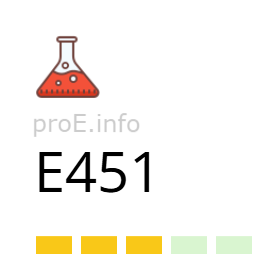
Other names for the additive (synonyms)
General Information
Additive E451 (triphosphates) refers to the salts of tripolyphosphoric acid used in the food industry as an acidity regulator, emulsifier, stabilizer, texturizer, and chelating agent. The additive is entirely synthetic and does not occur naturally.
In industry, triphosphates are produced by heating and chemically reacting various phosphoric acids with sodium or potassium salts. These reactions enable synthesizing the required compounds with high purity for use in the food industry.
According to the International Numbering System for Food Additives Codex Alimentarius CXG 36-1989, there are three subtypes of additive E451:
- E451(i) — sodium triphosphate (Na5P3O10);
- E451(ii) — potassium triphosphate (K5P3O10);
- E451(iii) — sodium potassium triphosphate.
Only the first two are included in the General Standard for Food Additives STAN 192-1995.
All three substances are white crystalline powders soluble in water. Additives E451 have an alkaline reaction and a pronounced ability to retain moisture and bind metal ions.
Effects on the Body
Benefits of E451
Triphosphates are not essential nutrients for humans but may play a minor role in regulating acid-base balance. In the body, they quickly hydrolyze into orthophosphates, which are metabolically active compounds. However, E451 offers no direct health benefits.
Harms of E451
Excessive intake of triphosphates can disrupt calcium and phosphorus metabolism, contribute to kidney stone formation, and increase the risk of osteoporosis. Exceeding the acceptable daily intake (ADI) may cause digestive issues.
Some studies indicate that chronic excessive phosphate intake may lead to the following adverse effects:
- Hyperphosphatemia: mineral imbalance due to elevated phosphate levels in the blood.
- Vascular calcification: reduced vessel elasticity and increased risk of atherosclerosis.
- Heart disease: higher likelihood of heart attacks and heart failure.
- Increased mortality: phosphate excess is associated with higher death rates.
- Calcium-phosphorus imbalance: decreased calcium absorption and bone demineralization.
- Kidney strain: phosphate elimination burdens kidney function, especially in chronic disease.
- Arthropathies: joint inflammation due to phosphate crystal deposits.
- Osteoporosis: weakened bones and increased fracture risk.
- Raised "bad" cholesterol: increased LDL levels in the blood.
- Kidney stones: formation of calcium-phosphate compounds as calculi.
In 2019, the European Food Safety Authority (EFSA) reviewed scientific data on phosphates and concluded that they do not cause mutagenic effects or affect fertility or offspring development.
The EFSA Panel set an acceptable daily intake (ADI) for the phosphate group, expressed as phosphorus, at 40 mg/kg of body weight. This level is considered safe for the general population.
Uses
In the food industry, additive E451 is used as an acidity regulator, stabilizer, texturizer, and fat emulsifier.
It is used in the production of meat and fish products, ice cream, sterilized and pasteurized milk, processed and young cheeses, butter, egg mixtures, non-alcoholic and sports drinks. E451 is found in dry soups, pasta, confectionery, glazes, margarine, and syrups. It may also be used in baking cakes and muffins, as well as for freezing and preserving fish and shellfish.
Triphosphates are often used in combination with other phosphates (such as E452, E450), especially in meat processing. E451 improves the water-binding capacity of proteins and prevents moisture loss in finished products.
Beyond the food industry, triphosphates are widely used in household chemicals (laundry detergents, cleaning agents) and in the cosmetics industry.
Legal Status
E451 is approved for use in the food industry in most countries. In the European Union, it is authorized under Regulation (EC) No 1333/2008, and in the United States, it is recognized as safe (GRAS) by the FDA.
The additive is also permitted and widely used in Ukraine, Canada, Japan, and many other countries.